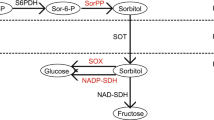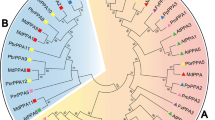Abstract
Although housekeeping functions have been shown for the phosphoenolpyruvate carboxylase (EC 4.1.1.31, PEPC) in plants and in prokaryotes, PEPC is mainly known for its specific role in the primary photosynthetic CO2 fixation in C4 and CAM plants. We have shown that in Sorghum, a monocotyledonous C4 plant, the enzyme is encoded in the nucleus by a small multigene family. Here we report the entire nucleotide sequence (7.5 kb) of the third member (CP21) that completes the structure of the Sorghum PEPC gene family. Nucleotide composition, CpG islands and GC content of the three Sorghum PEPC genes are analysed with respect to their possible implications in the regulation of expression. A study of structure/function and phylogenetic relationships based on the compilation of all PEPC sequences known so far is presented. Data demonstrate that (1) the different forms of plant PEPC have very similar primary structures, functional and regulatory properties, (2) neither apparent amino acid sequences nor phylogenetic relationships are specific for the C4 and CAM PEPCs and (3) expression of the different genes coding for the Sorghum PEPC isoenzymes is differently regulated (i.e. by light, nitrogen source) in a spatial and temporal manner. These results suggest that the main distinguishing feature between plant PEPCs is to be found at the level of genes expression rather than in their primary structure.
Similar content being viewed by others
References
Andreo CS, Gonzalez DH, Iglesias AA: Higher plant phosphoenolpyruvate-carboxylase, structure and regulation. FEBS Lett 213: 1–8 (1987).
Bird A: CpG-rich islands and the function of DNA methylation. Nature 321: 209–213 (1986).
Callis J, Fromm M, Walbot V: Introns increase gene expression in cultured maize cells. Genes Devel 1: 1183–1200 (1987).
Campbell WH, Gowri G: Codon usage in higher plants, green algae and cyanobacteria. Plant Physiol 92: 1–11 (1990).
Chao S, Raines CA, Longstaff M, Sharp PJ, Gale MD, Dyer TA: Chromosomal location and copy number in wheat and some of its close relatives of genes for enzymes involved in photosynthesis. Mol Gen Genet 218: 423–430 (1989).
Chardot TP, Wedding R: Role of cysteine in activation and allosteric regulation of maize phosphoenolpyruvate carboxylase. Plant Physiol 98: 780–783 (1992).
Cockburn W: Stomatal mechanism as the basis of the evolution of CAM and C4 photosynthesis. Plant Cell Envir 6: 275–279 (1983).
Crawford JD: Plant Molecular Systematics: Molecular Approaches. Wiley-Interscience, New York (1990).
Crétin C, Keryer E, Tagu D, Lepiniec L, Vidal J, Gadal P: Complete cDNA sequence of Sorghum phosphoenolpyruvate carboxylase involved in C4 photosynthesis. Nucl Acids Res 18: 658 (1990).
Crétin C, Bakrim N, Kéryer E, Santi S, Lepiniec L, Vidal J, Gadal P: Production in Escherichia coli of active Sorghum phosphoenolpyruvate carboxylase which can be phosphorylated. Plant Mol Biol 17: 83–88 (1991).
Crétin C, Santi S, Kéryer E, Lepiniec L, Tagu D, Vidal J, Gadal P: The phosphoenolpyruvate carboxylase gene family in Sorghum: promoter structure, amino acid sequences and expression of genes. Gene 99: 87–94 (1991).
Cronquist A: An Integrated System of Classification of Flowering Plants. Columbia University Press, New York (1981).
Cushman JC, Meyer G, Michalowski CB, Schmitt JM, Bohnert HJ: Salt stress leads to differential expression of two isogenes of phosphoenolpyruvate carboxylase during Crassulacean acid metabolism induction in the common ice plant. Plant Cell 1: 715–725 (1989).
Dessens P, Fondrat C, Valencien C, Mugnier C: A French service for access to biomolecular sequences databases. CABIOS 6: 355–356 (1990).
D'Onofrio G and Bernardi G: A universal compositional correlation among codon positions. Gene 110: 81–88 (1992).
Dover GA: DNA turnover and the molecular clock. J Mol Evol 26: 47–58 (1987).
Dover GA, Flavell RB: Molecular coevolution: DNA divergence and the maintenance of function. Cell 38: 622–623 (1984).
Eikmanns BJ, Follettie MT, Griot MU, Sinskey AJ: The phosphoenolpyruvate carboxylase gene of Corynebacterium glutamicum. Mol Gen Genet 218: 330–339 (1989).
Felsenstein J: Phylogenies from molecular sequences: inference and reliability. Annu Rev Genet 22: 521–565 (1988).
Fujita N, Miwa T, Ishijima K, Katsuki H: The primary structure of phosphoenolpyruvate carboxylase of E. coli. J Biochem 95: 909–916 (1984).
Gardiner-Garden M, Sved JA and Frommer M: Methylation sites in angiosperm genes. J Mol Evol 34: 219–230 (1992).
Gardiner-Garden M, Frommer M: Significant CpG-rich regions in angiosperm genes. J Mol Evol 34: 231–245 (1992).
Goodall GJ, Filipowicz W: Different effects on intron nucleotide composition and secondary structure on pre-mRNA splicing in monocot and dicot plants. EMBO J 10: 2635–2644 (1991).
Grula JW, Hudspeth RL: The phosphoenolpyruvate carboxylase gene family of maize. In: Key JL, McIntosh L (eds) Plant Gene Systems and their Biology, pp. 207–216 (1987).
Higgins DG, Sharp PM: Clustal: a package for performing multiple sequence alignment on a microcomputer. Gene 73: 237–244 (1988).
Hudspeth RL, Grula JW: Structure and expression of the maize gene encoding the phosphoenolpyruvate carboxylase isozyme involved in C4 photosynthesis. Plant Mol Biol 12: 579–589 (1989).
Jiao J, Chollet R: Posttranslational regulation of phosphoenolpyruvate carboxylase in C4 and Crassulacean acid metabolism plants. Plant Physiol 95: 981–985 (1991).
Joshi CP: Putative polyadenylation signals in nuclear genes of higher plants: a compilation and analysis. Nucl Acid Res 15: 9627–9641 (1987).
Kahler AL, Hallauer AR, Gardner C: Allozyme polymorphisms within and among openpollinated and adapted exotic populations of maize. Theor Appl Genet 72: 592–601 (1986).
Kano-Murakami Y, Suzuki I, Sugiyama T, Matsuoka M: Sequence-specific interactions of maize factor with a GC-rich rich repeat in the phosphoenolpyruvate carboxylase gene. Mol Gen Genet 225: 203–208 (1991).
Katagiri F, Kodaki T, Fujita N, Izui K, Katsuki H: Nucleotide sequence of the phosphoenolpyruvate carboxylase gene of cyanobacterium Anacystis nidulans. Gene 38: 265–269 (1985).
Kawamura T, Shigesada K, Yanagisawa S, Izui K: Phosphoenolpyruvate carboxylase prevalent in maize roots: Isolation of a cDNA clone and its use for analyses of the gene and gene expression. J Biochem 107: 165–168 (1990).
Kimura M: Molecular evolutionary clock and the neutral theory. J Mol Evol 26: 24–33 (1987).
Koizumi N, Sato F, Terano Y, Yamada Y: Sequence analysis of cDNA encoding phosphoenolpyruvate carboxylase from cultured tobacco cells. Plant Mol Biol 17: 535–539 (1991).
Kozak M: Compilation and analysis of sequences upstream from the translational start site in eukaryotic mRNA. Nucl Acids Res 12: 857–872 (1984).
Langdale JA, Nelson T: Spatial regulation of photosynthetic development in C4 plants. Trends Genet 7: 191–196 (1991).
Langdale JA, Taylor WC, Nelson T: Cell-specific accumulation of maize phosphoenolpyruvate carboxylase is correlated with demethylation at a specific site > 3 kb upstream of the gene. Mol Gen Genet 225: 49–55 (1991).
Lepiniec L, Santi S, Kéryer E, Amiet V, Vidal J, Gadal P, Crétin C: Complete nucleotide sequence of one member of the Sorghum phosphoenolpyruvate carboxylase gene family. Plant Mol Biol 17: 1077–1079 (1991).
Lepiniec L, Kéryer E, Tagu D, Gadal P, Crétin C: Complete nucleotide sequence of a Sorghum gene coding for the phosphoenolpyruvate carboxylase involved in C4 photosynthesis. Plant Mol Biol 19: 339–342 (1992).
Luinenburg I, Coleman JR: Identification, characterization and sequence analysis of the gene encoding phosphoenolpyruvate carboxylase in Anabaena sp. PCC7120. J Gen Microbiol 138: 685–691 (1992).
Martinez P, Martin W, Cerff R: Structure, evolution and anaerobic regulation of a nuclear gene encoding cytosolic glyceraldehyde-3-phosphate dehydrogenase from maize. J Mol Biol 208: 551–565 (1989).
Martin W, Gierl A, Saedler H: Molecular evidence for pre-cretaceous angiosperm origins. Nature 339: 46–48 (1989).
Matsuoka M, Shingo H: Comparative studies of phosphoenolpyruvate carboxylase from C3 and C4 plants. Plant Physiol 85: 947–951 (1987).
Monson RK, Moore BD: On the significance of C3–C4 intermediate photosynthesis to the evolution of C4 photosynthesis. Plant Cell Envir 12: 689–699 (1989).
Montero LM, Salinas J, Matassi G, Bernardi G: Gene distribution and isochore organisation in the nuclear genome of plants. Nucl Acids Res 18: 1859–1867 (1990).
Ngernprasirtsiri J, Chollet R, Kobayashi H, Sugiyama T, Akazawa T: DNA methylation and the differential expression of C4 photosynthesis genes in mesophyll and bundle sheath cells of greening maize leaves. J Biol Chem 264: 8241–8248 (1989).
Nelson T, Langdale JA: Developmental genetics of C4 photosynthesis. Annu Rev Plant Physiol Plant Mol Biol 43: 25–47 (1992).
Ochman H, Wilson AC: Evolution in bacteria: evidence for a universal substitution rate in cellular genome. J Mol Evol 26: 74–86 (1987).
Otha T: Multigene families and the evolution of complexity. J Mol Evol 33: 34–41 (1991).
Poetsh W, Hermans J, Westhoff P: Multiple cDNAs of phosphoenolpyruvate carboxylase in the C4 dicot Flaveria trinervia. FEBS Lett 292: 133–136 (1991).
Razin A, Cedar H: DNA methylation and gene expression. Microbiol Rev 55: 451–458 (1991).
Saitou N, Nei N: The neighbor-joining method: A new method for reconstructing phylogenetic trees. Mol Biol Evol 4: 406–425 (1987).
Sambrook J, Fritsch EF, Maniatis T: Molecular Cloning: A Laboratory Manual, 2nd ed. Cold Spring Harbor Laboratory, Cold Spring Harbor, NY (1989).
Schäffner AR, Sheen J: Maize C4 photosynthesis involves differential regulation of phosphoenolpyruvate carboxylase genes. Plant J 2: 221–232 (1992).
Schuller KA, Plaxton WC, Turpin DH: Regulation of phosphoenolpyruvate carboxylase from the green alga selenastrum minutum. Plant Physiol 93: 1303–1311 (1990).
Springer PS, Zimmer EA, Bennetzen JL: Genomic organization of the ribosomal DNA of Sorghum and its close relatives. Theor Appl Genet 77: 8844–8850 (1989).
Sueoka N: Directional mutation pressure, selective constraints and genetic equilibria. J Mol Evol 34: 95–114 (1992).
Tang H, Dube SK, Liang GH, Kung SD: Possible repetitive DNA markers for eusorghum and parasorghum and their potential use in examining phylogenetic hypotheses on the origin of Sorghum species. Genome 34: 241–250 (1991).
Terada K, Izui K: Site-directed mutagenesis of the conserved histidine residue of phosphoenolpyruvate carboxylase: His 138 is essential for the second partial reaction. Eur J Biochem 202: 797–803 (1991).
Ting IP, Osmond CB: Photosynthetic phosphoenolpyruvate carboxylases, characteristics of alloenzymes from leaves of C3 and C4 plants. Plant Physiol 51: 439–447 (1973).
Troitsky AV, Melekhovets YF, Rakhimova GM, Bobrova VK, Valiejo-Roman KM, Antonov AS: Angiosperm origin and early stages of seed plant evolution deduced from rRNA sequences comparisons. J Mol Evol 32: 256–261 (1991).
VanQuy L, Foyer C, Champigny ML: Effect of light and NO3 on wheat leaf phosphoenolpyruvate carboxylase activity. Plant Physiol 97: 1476–1482 (1991).
Whittier RF, Sugimoto T, Kawasaki T, Shibata D, Kawamura Y: Cloning and characterization of PEPC cDNA from soybean, a C3 plant. ISPMB congress, Tucson. Abstract 1852 (1991); and Sugimoto T, Kawasaki T, Kato T, Whittier RF, Shibata D, Kawamura Y: cDNA sequence and expression of a phosphoenolpyruvate carboxylase gene from soybean. Plant Mol Biol, in press.
Woese CR: Bacterial evolution. Microbiol Rev 51: 221–271 (1987).
Wolfe KH, Gouy M, Yang YW, Sharp PM, Li WH: Date of monocot-dicot divergence estimated from chloroplast DNA sequence data. Proc Natl Acad Sci USA 86: 6201–6205 (1989).
Yanagisawa S, Izui K: Maize phosphoenolpyruvate carboxylase involved in C4 photosynthesis: nucleotide analysis of the 5′ flanking region of the gene. J Biochem 106: 982–987 (1989).
Yanagisawa S, Izui K: Multiple interactions between tissue-specific nuclear proteins and the promoter of the phosphoenolpyruvate carboxylase gene for C4 photosynthesis in zea maize. Mol Gen Genet 224: 325–332 (1990).
Zuckerland E: The molecular evolutionary clock. J Mol Evol 26: 34–46 (1987).
Author information
Authors and Affiliations
Rights and permissions
About this article
Cite this article
Lepiniec, L., Keryer, E., Philippe, H. et al. Sorghum phosphoenolpyruvate carboxylase gene family: structure, function and molecular evolution. Plant Mol Biol 21, 487–502 (1993). https://doi.org/10.1007/BF00028806
Received:
Accepted:
Issue Date:
DOI: https://doi.org/10.1007/BF00028806




